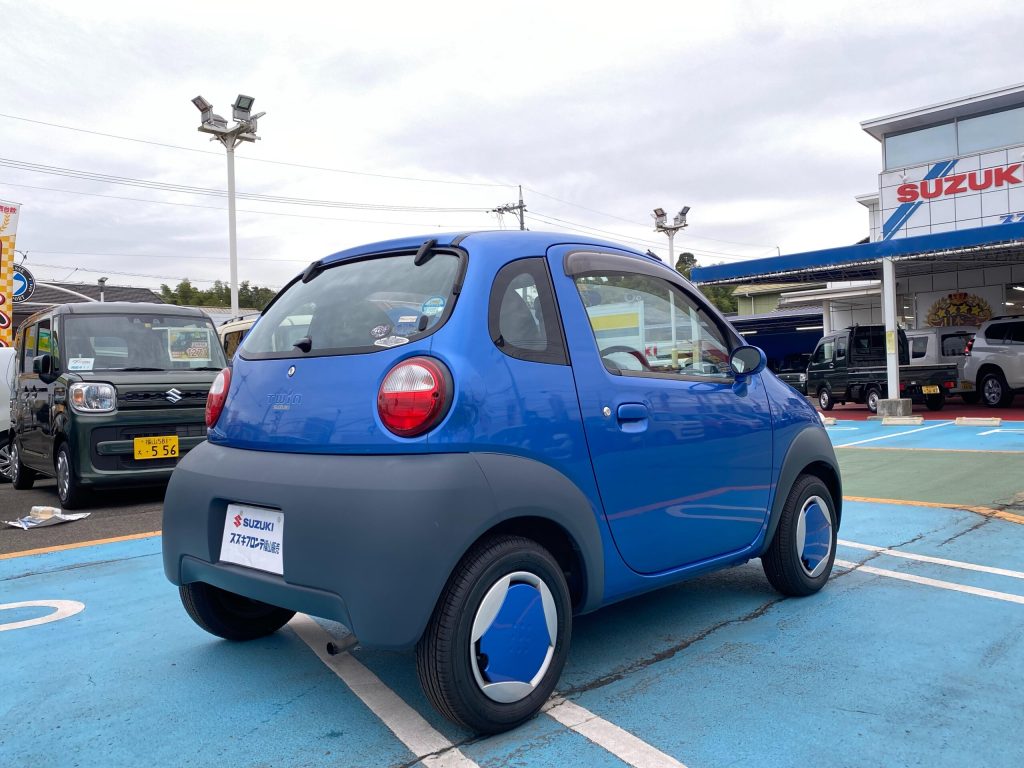Short of possibly Fiat, no company knows small cars like Suzuki. And no Suzuki with four wheels has been quite as small as the Suzuki Twin, sold in Japan between 2003 and 2005.
At 2735mm long, it’s a couple of inches longer than the current Smart Fortwo, and at 1475mm wide, a great deal narrower – just a couple of inches wider than an original Mini. Among modern vehicles, only quadricycles like the Citroën Ami are notably smaller.
The two-seat Twin was a proper car, and a clever one. Previewed by the Pu3-Commuter concept at the 1999 Tokyo Motor Show, the Twin was closely related to the kei-class Suzuki Alto of the time.
Using its 658cc in-line three-cylinder, Suzuki cropped 560mm from the Alto’s wheelbase, shrinking it to only 1.8 metres, and enabling a kerb-to-kerb turning circle of 7.2 metres – tighter even than the 7.8 metres of the famously nimble Toyota iQ that arrived later in the decade.


The design is cartoonishly cute. According to Japanese car magazine Car Graphic, Suzuki’s design chief, Moriyoshi Hattori, described it as looking like a car “that a child would draw”. Bright colours accentuated the toy-like lines and bulbous headlights and tail lights, while upscale models even featured colour-matched wheel trims.
If the naturally-aspirated K6A triple behind that Disney dinosaur nose featured a distinctly 1970s power output of only 43bhp, then it only had to motivate a kerb weight of 570kg for the five-speed manual version, a hundred kilos lighter than late Rover Minis.
The really clever bit was that you could also purchase the Twin as Japan’s first hybrid kei car. To keep the price down – at 1,290,000 Yen in 2003, it came in at about £8200, inflation-adjusted for 2022 – the hybrid used a very simple setup comprising linked 12v motorcycle lead-acid batteries, and a 5kW (7bhp), 8cm-deep motor sandwiched between the engine and four-speed automatic gearbox.
The payoff was claimed fuel consumption of 96mpg, and while Japan’s economy testing schedule is based on even lower speeds and easier driving than the optimistic European tests, that figure is within a whisker of the 98mpg claimed of the original Honda Insight – so a real-world 70-80mpg seems feasible. If you’re concerned about battery life, lead-acid makes replacement cheap and easy. Green, too – lead-acid batteries are among the most recyclable, and most recycled, consumer products.

What the hybrid’s 70-80mpg was unlikely to do is offset the price difference to the base model Twin. If you think eight grand sounds cheap, the entry-level Twin’s 490,000 Yen price equates to a frankly unbelievable £3100 in today’s money – a figure, according to Hattori, selected to try and match the advertised price of the original Alto from 1979.
Hagerty contributor Tom Barnard recalls that Suzuki considered bringing the Twin over to the UK at one stage, with a price pitched at under £5000. This would have made it comfortably the cheapest car in the UK in the early 2000s, if not quite as absurdly affordable as it was in Japan.
At three grand, buyers could surely forgive the Twin’s somewhat basic accoutrements. There was no stereo as standard, and the optional unit fitted for some featured only a single speaker in the single-DIN unit.
Luggage access was by lifting the rear screen – with no Smart-style drop-down tailgate – while interior materials were as basic as they came in 2003. There was no air conditioning or power steering on entry cars either, though the more lavish automatics (including the hybrid) featured both.


It wasn’t impractical, that basic luggage area being completely flat, and the passenger seat similarly folding completely flat (a cue perhaps nicked from Smart, whose Fortwo passenger seat did similar). There is also something to be said for a car so basic that there’s virtually nothing to go wrong, or to damage.
As Smart has discovered though, and Toyota with its iQ, the market for truly small cars is itself fairly small in the modern era, even in tiny-car-friendly Japan. The Twin survived for only two years, with around 10,000 finding homes, before the Alto once again took over as Suzuki’s smallest, simplest model.
Twins remain easy to find in Japan’s classifieds today, with prices starting at under £2000 before shipping – though as domestic market enthusiasts warm to the car’s charms, the best examples are already asking significantly more than that.
With so many classic European small cars so easy to find on UK shores, and shipping not as cheap as it once was, you’d have to be a dedicated JDM nut to bring across an example of Suzuki’s idiosyncratic Twin. But with some creative use of a shipping container, perhaps someone could do you a bulk deal…
Read more
Kei Cars are Japan’s SUVs – Autozam AZ-1, Honda Beat, Suzuki Cappuccino | Revelations with Jason Cammisa
Tiny Happy People: Driving a titchy classic kei car is big fun
Review: The Ami city car is Citroën’s welcome return to stranger things









